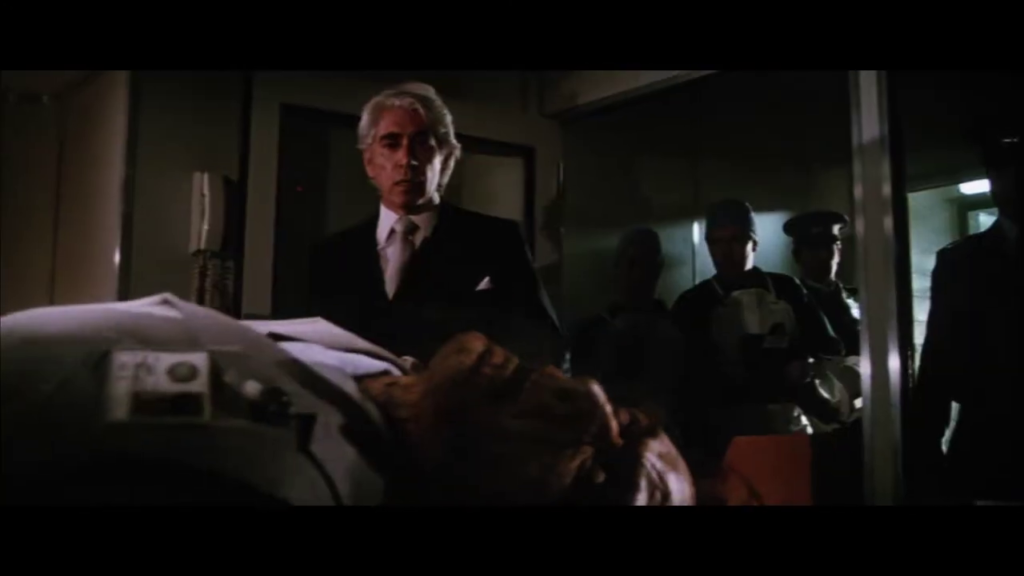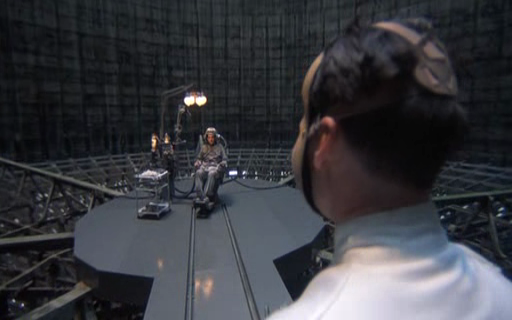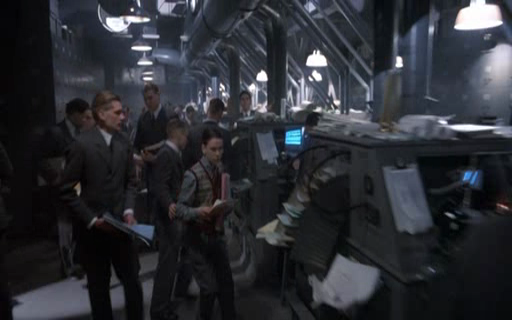-
#599 – Lifeforce (1985)










Lifeforce (1985)
Film review #599
Director: Tobe Hooper
SYNOPSIS: A space shuttle investigating Halley’s Comet finds a ship hidden in it’s wake. Inside they find three humanoid bodies, and bring them back to Earth. Upon arrival, Mission control gets no response, and send another shuttle to investigate. Aboard, they find the shuttle has been destroyed by a fire, and all that is intact is one of the preserved human bodies found on the alien ship. brought back to earth for study, the body wakes up and proceeds to start sucking the life out of people she encounters, setting off a chain effect that turns her victims into “vampire” like creatures that feed off others. Colonel Caine of the SAS joins forces with the sole survivor of the shuttle, who escaped via escape pod, to find the alien and stop her before she turns the human race into soul-sucking vampires…
THOUGHTS/ANSLYSIS: Lifeforce is a 1985 sci-fi film partly based on the novel The Space Vampires by Colin Wilson. A space shuttle investigating Halley’s comet finds a spaceship in its orbit, and aboard, they find three preserved humanoid bodies, which they decide back to Earth. When they are brought back by a second shuttle after the first one was mysteriously damaged and everyone aboard killed, the alien wakes up and starts sucking the life out of people, leading to a race against time to stop her before she infects everyone. Relying on a typical monster hunt with a sci-fi twist in the form of “space vampires,” the film wanders about through different locations and characters without too much direction other than stopping the monster. Everything is played quite low-key without theatrics (apart from a fair amount of female nudity), and the film revels in trying to create an eerie atmosphere more than anything else.
The film just keeps adding in more weird elements as it goes on, never stopping to really tie things together: there’s a feeling that the filmmakers just wanted to keep going after they could have stopped, turning it into a passion project of sorts. The flimmakers were given a bunch of money without much oversight and sent to make a movie, resulting in a film that you only really get with certain element of creative freedom. I like to call it the Zardoz effect: when a film has little to no oversight and creative juices just run wild, creating a product which never settles neatly into being a “good” or “bad” film, and refuses categorisation due to a certain restless creative energy. Lifeforce, to be clear, is nowhere near the brazen, lucid, fever dream that Zardoz is, but there’s just enough weirdness to make you think twice about how to judge it.
There’s not really much to the characters, although the performances are pretty good: the film relies more on atmosphere than stand out personalities. One part of the film which does leave an impression is the practical effects, with the scenes of people having their lifeforce sucked out and becoming deflated husks having that creepy horror vibe actually rather impressive, and a testament to the power of practical effects. Overall, Lifeforce takes the classic b-movie monster schtick and runs with it past its limits, and just revels in the thrill of making films. The result is difficult to judge in terms of good and bad: it’s just bizarre, although not enough to really make it stand out.
-
#366 – Pulgasari (1985)
Pulgasari (1985)
Film review #366
Director: Shin-Sang-Ok
SYNOPSIS: A small village is by invaders who try to force the blacksmith to make weapons for them. When he refuses, he is sent to prison without food until he changes his mind. In his dying moments, he creates a small figure that he vows will destroy the invaders. When the figure comes alive in front of Ami, the blacksmith’s daughter, she realises the creature grows bigger with the more iron it eats, and the villagers begin feeding the creature their iron in order to fight the imperial invaders…
THOUGHTS/ANALYSIS: Pulgasari is a 1985 monster film and the first film I have reviewed from North Korea. The story behind the film is just as interesting as the film itself. The director, Shin Sang-ok, was kidnapped with his wife by North Korea for the intention of producing films such as Pulgasari for the government. Kim Jong-il, the leader of North Korea, was apparently a huge fan of the Godzilla films, and wanted to create his own version, thus why he is listed as the executive producer on this film. For around ten years Shin Sang-ok and his wife (an actress in her own right) were forced to make films for the government before eventually escaping when they were visiting a film festival in Austria and fleeing their North Korean minders. Pulgasari was the last film he directed before he made this escape.This whole story would probably make an interesting film in and of itself…
With regards to Pulgasari itself, the film opens up in a remote village in the past. A young man named Inde wants to leave the village to join a group of rebels/bandits living in the mountains, but Ami, a woman in the village who he is due to wed, does not want him to go. This drama is interrupted as an army enters the town to commission the blacksmith, Ami’s Father, to create weapons for their army. They take all of the iron items from the villagers to use in creating these weapons, which leads the blacksmith to refuse to help them. They respond by locking him up without food until he changes his mind. Just before he dies of starvation, the blacksmith creates a small figurine of the mythical monster Pulgasari which he puts his soul into, with the aim of protecting the village. When Ami gets the figure, she accidentally drips some of her blood onto it and causes it to come alive and start eating anything made of iron. As Pulgasari grows with everything he eats, the villagers and the rebels in the mountains rally behind the indestructible Pulgasari to drive away the invaders. The story as a whole is fairly simple, with a number of battles between the villagers and the imperial army, with a number of schemes by the King to stop Pulgasari as he relentlessly advances towards him. I suppose it doesn’t need to be much more complicated than a giant monster smashing stuff, and in that respect the film does its job fairly well. Some of the scenes centred around the other characters can dragon a little too long, and there are large gaps in between when Pulgasari makes an appearance which become rather dull. Nevertheless, Ami is a decent (and rare) female lead, and the setting is fairly well established.
The film is set in the past, and feels like it relies a lot on the history of Korea during that era. The villains are clearly meant to be Japanese, which is a typical portrayal of the country given it’s past in occupying Korea, and North Korea’s particular resentment of them. As you might expect, the film not so subtly fulfils the propaganda of the North Korean narrative, with the common workers banding together to overthrow the invading, imperial rule. In the end, Pulgasari becomes too big and continues to eat all the iron even after the invaders are gone. This leads to Ami sacrificing herself to stop Pulgasari. This is perhaps a reference to the revolution in North Korea leading to the creation of a monster that will bring about their destruction was a slight dig by the captive director at the regime that was holding him hostage, but it’s difficult to say for sure.
I was expecting a rather barebones film out of North Korea, and it more or less met those expectations. The production values and special effects aren’t much improved on the Godzilla films made thirty years prior. Nevertheless, just as those films still hold up well, some of the scenes in this film look fairly decent, particularly watching Pulgasari destroying buildings. The battle scenes as well feature a host of extras to give the feel of armies clashing. Some of the effects though, are pretty bad, such as when Pulgasari is small, you can clearly tell it is a hand puppet. The body suit of Pulgasari is again pretty decent, and has some moving parts and facial animations to make it more convincing. The soundtrack consists of a single synthesiser being played in more dramatic scenes, and is barely worth mentioning, but overall the film ended up being more well made than I was expecting. Pulgasari doesn’t offer anything new or exciting to the genre, and it loses some of it’s significance outside of it’s home country, but it is a rare and interesting example of cinema from a place you wouldn’t normally see.
-
#16 – Brazil (1985)
Brazil (1985)
Film review #16
Director: Terry Gilliam
A science-fiction film where information is king…
In an unidentified country, a man named Sam Lowry often find himself dreaming about saving a beautiful woman. In reality however, he is a low-level government employee at the ministry of records. Information and paperwork rules society here, and mistakes are unheard of. However, Sam is given the task of rectifying a mistake that caused Archibald Buttle instead of Archibald Tuttle to be arrested and (accidentally) killed.
Sam goes to deliver a reimbursement cheque to the widowed Mrs Buttle, since any cost of arrest and detainment are met by the perpetrator. She is however, stricken with grief, and refuses to fill out the paperwork. Sam then sees the woman living upstairs and recognises her as the woman from his dreams, he gives chase and loses her, but learns her name: Jill Lawton. However, he cannot access her records because she is considered a suspect for trying to report the mistake of Buttle’s arrest to a government that does not admit to making mistakes. When he returns home, he meets the real Tuttle, who helps to fix his air conditioning when it fails and Central Services (the company that handles all the repairs) is short-staffed. Tuttle is a renegade repairman who fixes things without the assistance of Central Services, which is highly illegal.
Sam figures the only way to get access to Jill’s records and her location is to accept his Mother’s help to get promoted to the Ministry of information retrieval. He goes to see her while she is in the midst of more plastic surgery. When he arrives at his new office at the ministry, he retrieves the records and tracks her down before she is arrested, after declaring he is in love with her, he erases her records to classify her as deceased. After sharing a romantic night with her, Sam is arrested.
Sam is tied to a chair ready for interrogation for misusing his government position. His old friend Jack is carrying out the interrogation, where he tells Sam Jill was killed resisting arrest. Suddenly, Tuttle and the resistance rappel in from the roof and free him. They break out of the ministry and go on the run, where Tuttle seems to disappear in a flurry of paperwork. Sam then stumbles upon the funeral of his Mother’s friend who has died from excessive plastic surgery. Sam’s mother now looks younger than him thanks to the plastic surgery, and Sam escapes in horror, and is rescued by Jill in her truck, and the two drive off into the sunset. This happy ending turns out to be short-lived however, when the scene cuts back to the interrogation room, where Sam has gone catatonic from the interrogation, and the film ends with him humming “Brazil” as Jack and the information minister exit the room…
Brazil is a very British film, featuring an almost entirely British cast. The ministries and locations are reminiscent of something you would find in Britain rather than the US for example. The humour lends itself to become a black comedy, similar to other British films such as Monty Python or Time Bandits (Also produced by Terry Gilliam). This comedic element is a very fresh take on the science-fiction genre, since the two are rarely combined. The dystopic nature of the film too is also a different take on future society which is favoured by Britain over the utopian views of the US, as shown by British TV shows such as Doctor Who.
The direction and design are reminiscent of other films and future views. For example, the retro-fitted design of the city filled with neon lighting and tightly packed rooms filled with electronics is similar to Blade Runner, while the concept of government being flawless and all knowledgeable is similar to George Orwell’s 1984. It should be noted that While Blade Runner was meant to represent a near future (2020), Brazil is very much a reflection on the (then) present day government. In this respect, it relates to how 1984 was written about a futuristic 1984, but Gilliam notes it is a “Nineteen-Eighty Four for 1984”, seemingly eager to emphasise its relevance to contemporary society. Unlike 1984 though, it lacks any sort of “Big brother” figure who ultimately watches and rules society. the architecture itself seems to be somewhat similar to the movie Metropolis as well. The dream sequences in Brazil also have a similarity to the dream sequences in Blade Runner. Neither film really explains the dreams, but perhaps they show the desire for people to break out of the regimented control of society. The suits, hats and waistcoats wore by the workers gives the movie a 40’s “noir” feel too, and makes the film feel like a 1940’s vision of 1985, with some things the same, but some things quite different. This again gives the movie a strange uncertainty about its location in time. As we look back on movies from the past with a “comical aesthetic” and find the sets and props rather humours in their inaccuracy, it could be concluded that this is what Gilliam intentionally wanted for Brazil, which fits the black comedy nature of the script nicely.
As Brazil is perhaps more of a present day take on society than 1984 or Blade Runner (As the beginning of the film says it takes place “sometime in the 20th century), we do not really see futuristic technology on display, but we see a different way of utilising technology than we do now. For example, the telephones look like telephones, but seem to have a completely different way of working than how we would normally use them. The same goes with computers, which look like a typewriter with a strange transparent screen, although many people did not have personal computers in 1985, they did not look look like what they do in the film. The duct-pipes have a very distinctive style, with these long inflatable pipes running through every location. When we see the inside of the air conditioning of Sam’s apartment, we see a mess of ducts and pipes that is carefully hidden behind these large metal plates. I can’t help but think this is a commentary of how society and governments likes to hide all the inconvenient mess behind clean, shiny coverings…except in the working-class homes, the ducts have not tried to be hidden, but seem to snake around the homes and obstruct the people that live there.
Brazil was not much of a success at the box office (The US box office especially), probably due to its unhappy ending, and coming in at nearly two and a half hours. Despite this, it has been recognised as a “cult film” and is highly regarded by critics, regularly appearing in top 10 lists for best science-fiction, British or cult films, and seems to have had an influence in the development of films, for example the apartment of Max Cohen in the movie Pi was inspired by this movie. I personally think it s definitely worth a watch when you have a two and a half hours, as it is a good mixture of social commentary, science-fiction and black humour, which is really enjoyable.




















